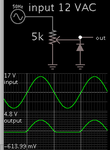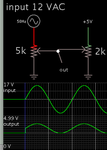UroBoros
Advanced Member level 2
- Joined
- May 5, 2004
- Messages
- 642
- Helped
- 19
- Reputation
- 38
- Reaction score
- 8
- Trophy points
- 1,298
- Location
- Cochin - India
- Activity points
- 6,463
I am trying to sample s sine wave for zero crossing detection as well as other measurements. But I would like to avoid the method of directly connection to AC mains using dropping resistor and then sampling.
My MCU works from a step down transformer power supply. So 0-12 v Step down isolated sine wave is available in my board. I prefer to use this voltage. correct me if I am wrong. somehow I feel the resistor network connected to live AC seems risky for me.
May I know how I can bring this step down transformer AC output wave to 0 to 5 volt range so that MCU ADC can see the waveform as centered in 2.5V.
Thank you
My MCU works from a step down transformer power supply. So 0-12 v Step down isolated sine wave is available in my board. I prefer to use this voltage. correct me if I am wrong. somehow I feel the resistor network connected to live AC seems risky for me.
May I know how I can bring this step down transformer AC output wave to 0 to 5 volt range so that MCU ADC can see the waveform as centered in 2.5V.
Thank you

